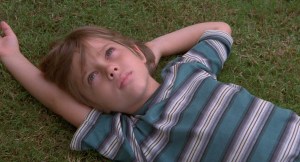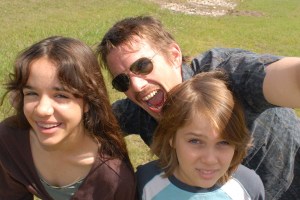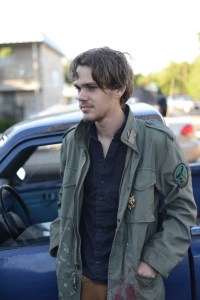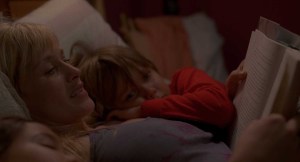 The coming-of-age saga, Boyhood, was shot for several days every year for 12 years. Tom Hammond, the sound supervisor and re-recording mixer, has worked many times with the director, Richard Linklater. Although Hammond was on the film from the start of production through the final mix, and key crew generally returned on an annual basis to do their part, sometimes schedules did not sync and new crew joined the team. This was the case with the production sound mixers on the film. Ethan Andrus worked on the shoot over the course of the first seven years, with Ben Lowry and Ben Lazard dividing the remaining years on the show with additional mixing from Mack Melson.
The coming-of-age saga, Boyhood, was shot for several days every year for 12 years. Tom Hammond, the sound supervisor and re-recording mixer, has worked many times with the director, Richard Linklater. Although Hammond was on the film from the start of production through the final mix, and key crew generally returned on an annual basis to do their part, sometimes schedules did not sync and new crew joined the team. This was the case with the production sound mixers on the film. Ethan Andrus worked on the shoot over the course of the first seven years, with Ben Lowry and Ben Lazard dividing the remaining years on the show with additional mixing from Mack Melson.
The mixers faced the challenge of changing audio technology in the production recording and in the postproduction workflow. For the first couple of years of shooting, Andrus used standard 2-track timecode DATs. Then, to get ISO channels before multi-channel production recorders were available, he rigged up an 8-channel ADAT studio recorder, like those used for multi-channel music recording, and ran it along with the 2-track DAT.
“It’s now moved on to multi-channel hard disk recorders, “ explained Andrus. “It’s a nice safety net and Tom loves it if somebody goofs up the mix and they can still go in and get the ISO tracks, but it requires a lot more on the production sound mixers than when it was 2-track.”
 The multi-channel recorders worked well on the Continental Club scene. Each one of the performers from that music scene was miked. “We used the in-house board and took direct outs off their insert patches to do those ISOs,” revealed Lowery, who was the production mixer for that shoot. “So when I mixed it and the camera panned across each of the performers, I simply brought up the level of that performer, like the bass, or the banjo, or the guitar, or the vocals, giving it a nice touch.”
The multi-channel recorders worked well on the Continental Club scene. Each one of the performers from that music scene was miked. “We used the in-house board and took direct outs off their insert patches to do those ISOs,” revealed Lowery, who was the production mixer for that shoot. “So when I mixed it and the camera panned across each of the performers, I simply brought up the level of that performer, like the bass, or the banjo, or the guitar, or the vocals, giving it a nice touch.”
The other technology that has improved over the time period that the film was shot, is the radio body microphones. With the older technology, if a radio microphone was used in a wide shot, the mixer would use a boom in the close-up coverage. That close-up sound could be used in editorial when cutting the wide angle. “Now the radios have gotten so good in terms of range and the way that they sound, it has become an expectation that whether the shot is wide or tight or medium, everybody’s miked,” Andrus continued. “The quality needs to be cinema quality all the time.”
For a naturalistic film like Boyhood, all the mixers noted that Linklater’s filming style was straightforward. “The way Rick shoots, we mike them to give the option to use it, but he covers everything so well,” Lazard added. “He would go in and give them so much in the close-ups that you could get everything off the boom mikes nice and clean. We just did the wires for those off-the-cuff moments that might have happened in the wider shot.”
 Hammond credited picture editor Sandra Adair for organizing the production sound over the years – captured on a multitude of recording technologies – so that the post sound crew could access it. “The ADAT presented the biggest challenge,” Hammond said. “It was not a good medium to record on, although at the time in the ’90s it was used a lot. We only had 2-track audio for most of the production, so when we needed to split out the multi-track, we had to either pull it from the cut material or pull it from the ADAT tapes. That was a challenge because the equipment isn’t used any more.”
Hammond credited picture editor Sandra Adair for organizing the production sound over the years – captured on a multitude of recording technologies – so that the post sound crew could access it. “The ADAT presented the biggest challenge,” Hammond said. “It was not a good medium to record on, although at the time in the ’90s it was used a lot. We only had 2-track audio for most of the production, so when we needed to split out the multi-track, we had to either pull it from the cut material or pull it from the ADAT tapes. That was a challenge because the equipment isn’t used any more.”
To pull the needed tracks, the sound team serviced an ADAT machine, which were known to eat tape. They loaded the tapes, got ProTools ready and pushed play, never stopping the tape until it was finished. Fortunately, they were able to get all the material into the computer without incident.
Hammond knew the production sound was well recorded, which meant most of the dialog editing consisted of cleaning up the audio, with very little ADR recording needed in post. Most of the ADR was group recordings, such as lines for one of the party scenes. Hammond credited lead effects editor, Justin Hennard, for the sound design. For almost a month and a half, multiple dialog editors went through all of the production audio, pulling lines. Then the team recorded a number of ADR sessions.
One scene, in which the characters strip down to their underwear and jump in water, could not be miked because there was no place to put the wireless. “We always knew there was going to be a problem,” said Hammond. “Rick talked to me – this was back in probably 2007 – about recording Ellar Coltrane then because we knew his voice was going to change. That was a special case where we recorded the ADR earlier.” In addition to replacing dialog, the post sound team had to fill with foley and re-create the whole soundscape of the scene to make the audience believe that it was all recorded on set.
 Hammond noted that Linklater likes to keep the work in Austin. When the mixing stage that they usually used was closed down, they mixed the film in the master bedroom of a house.
Hammond noted that Linklater likes to keep the work in Austin. When the mixing stage that they usually used was closed down, they mixed the film in the master bedroom of a house.
“The studio was torn apart and we moved a good portion of it,” shared Hammond. “We moved in the main console and leaned the panels against the wall. The speakers were way too big for the bedroom, but it did work. For the final week of the mix we took it to a Dolby-approved stage in Austin. There, we were able to do any tweaking because mixing in a small stage creates problems. The music tends to play a little bit loud so you bring it down a little too much. When we took it to the larger stage, we were able to adjust it correctly.”
“The challenge of a film like this is to make the sound seamless, so it sounds like it was all recorded in production,” Hammond concluded. Collaborating over the years, this mix of mixers stayed in sync with their commitment and passion for the project, creating a natural soundscape that complemented the film.





